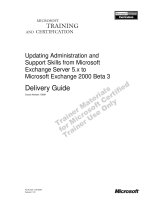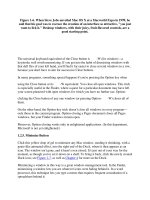PHP HOW TO 3 docx
Bạn đang xem bản rút gọn của tài liệu. Xem và tải ngay bản đầy đủ của tài liệu tại đây (171.68 KB, 10 trang )
$connString .= " user=$this−>username";
}
if ($this−>password) {
$connString .= " password=$this−>password";
}
$connString .= " dbname=$this−>databaseName";
$this−>_connectionID = @pg_pConnect($connString);
if ($this−>_connectionID) {
$this−>_isPersistentConnection = true;
}
return $this−>_connectionID;
}
// Returns: true on success, false on error Select
// the database name to be used PostgreSQL
// Note: function Not available
function selectDB($dbName) {
return false;
}
// Returns: the Recordset object disregard success
// or failure Send the sql statement to the database server
function execute($sql = "") {
// Instantiate an object without considering whether
// the query return any results or not
$this−>_queryID = @pg_Exec($this−>_connectionID, $sql);
$this−>_tempResultObj = new Recordset($this−>_queryID);
$this−>_insertQuery($this−>_queryID);
return $this−>_tempResultObj;
}
// Returns: the last error message from previous
// database operation
function errorMsg() {
$this−>_errorMsg = @pg_errormessage($this−>_connectionID);
return $this−>_errorMsg;
}
// Returns: true on success, false on failure
// Close the database connection
function close() {
if ($this−>_queryIDList && sizeof($this−>_queryIDList > 0)) {
while(list($_key, $_resultID) = each($this−>_queryIDList)) {
@pg_freeresult($_resultID);
}
}
// If its not a persistent connection, then
// only the connection needs to be closed
if ($this−>_isPersistentConnection != true) {
return @pg_close($this−>_connectionID);
}
else {
return true;
}
}
// A PRIVATE function used by the constructor function
// of the query object. insert the successful returned
// query id to the query id list. Used for later results
// cleanup. A private function that's never meant to
// be used directly
PHP HOW−TO
16.Appendix F PostgreSQL Database Wrapper Examples 28
function _insertQuery($query_id) {
$this−>_queryIDList[] = $query_id;
}
}
//−−−−−−−−−−−−−−−−−−−−−−−−−−−−−−
Class Name: Recordset
//−−−−−−−−−−−−−−−−−−−−−−−−−−−−−−
class Recordset
{
/* public variables */
var $fields;
// indicates that the current record position is before
// the first record in a Recordset object
var $BOF = null;
// indicates that the current record position is after
// the last record in a Recordset object
var $EOF = null;
/* private variables */
var $_numOfRows = −1; // NEVER change the value! READ−ONLY!
var $_numOfFields = −1; // NEVER change the value! READ−ONLY!
// Holds anything that was returned from the database specific functions
var $_tempResult = '';
// This variable keeps the result link identifier
var $_queryID = −1;
// This variable keeps the current row in the Recordset
var $_currentRow = −1;
// Returns: query id on success and false if
// failed Constructor function
function Recordset($queryID)
{
$this−>_queryID = $queryID;
if ($queryID) {
$this−>_numOfRows = @pg_numrows($this−>_queryID);
/* pg_numrows() returns −1 on error */
if ($this−>_numOfRows == −1) {
$this−>_numOfRows = 0;
}
$this−>_numOfFields = @pg_numfields($this−>_queryID);
/* pg_numfields() returns −1 on error */
if ($this−>_numOfFields == −1) {
$this−>_numOfFields = 0;
}
}
else {
$this−>_numOfRows = 0;
$this−>_numOfFields = 0;
}
/* If result set contains rows */
if ($this−>_numOfRows > 0 && $this−>_currentRow == −1) {
$this−>_currentRow = 0;
$this−>fields = @pg_fetch_array($this−>_queryID, $this−>_currentRow);
$this−>EOF = false;
$this−>BOF = false;
}
return $this−>_queryID;
}
// Returns: true if successful, false if fail Set the Recordset
PHP HOW−TO
16.Appendix F PostgreSQL Database Wrapper Examples 29
// pointer to a specified field offset. If the next call to
// fetchField() won't include a field offset, this field would
// be returned. PostgreSQL Note: function Not available
function fieldSeek($fieldOffset = −1) {
$this−>_tempResult = false;
return $this−>_tempResult;
}
// Returns: an object containing field information. Get column
// information in the Recordset object. fetchField() can be used
// in order to obtain information about fields in a certain query
// result. If the field offset isn't specified, the next field
// that wasn't yet retrieved by fetchField() is retrieved.
// PostgreSQL Note: function Not available
function fetchField($fieldOffset = −1) {
$this−>_tempResult = false;
return $this−>_tempResult;
}
// Returns: true if there still rows available, or false if there
// are no more rows. Moves to the next row in a specified Recordset
// object and makes that record the current row and the data
// corresponding to the row will be retrieved into the fields
// collection. Note: Unlike the moveRow() method, when _currentRow
// is getNumOfRows() − 1, EOF will immediately be true. If row number
// is not provided, the function will point to the
// first row automatically
function nextRow() {
if ($this−>getNumOfRows() > 0) {
$this−>fields = array();
$this−>_currentRow++;
$this−>fields = @pg_fetch_array($this−>_queryID, $this−>_currentRow);
/* This is not working. True all the time */
if ($this−>fields) {
$this−>_checkAndChangeEOF($this−>_currentRow − 1);
return true;
}
}
$this−>EOF = true;
return false;
}
// Returns: true on success, false on failure moveRow() moves
// the internal row pointer of the Recordset object to point
// to the specified row number and the data corresponding to
// the row will be retrieved into the fields collection. If
// row number is not provided, the function will point to
// the first row automatically
function moveRow($rowNumber = 0) {
if ($rowNumber == 0) {
return $this−>firstRow();
}
else if ($rowNumber == ($this−>getNumOfRows() − 1)) {
return $this−>lastRow();
}
if ($this−>getNumOfRows() > 0 && $rowNumber < $this−>getNumOfRows()) {
$this−>fields = null;
$this−>_currentRow = $rowNumber;
$this−>fields = @pg_fetch_array($this−>_queryID, $this−>_currentRow);
/* This is not working. True all the time */
if ($this−>fields) {
// No need to call _checkAndChangeEOF() because
PHP HOW−TO
16.Appendix F PostgreSQL Database Wrapper Examples 30
// the possibility of moving to the last row
// has been handled by the above code
$this−>EOF = false;
return true;
}
}
$this−>EOF = true;
return false;
}
// Returns: true on success, false on failure firstRow()
// moves the internal row pointer of the Recordset object
// to the first row and the data corresponding to the row
// will be retrieved into the fields collection
function firstRow() {
if ($this−>getNumOfRows() > 0) {
$this−>fields = array();
$this−>_currentRow = 0;
$this−>fields = @pg_fetch_array($this−>_queryID, $this−>_currentRow);
$this−>EOF = true;
/* This is not working. True all the time */
if ($this−>fields) {
return true;
}
}
$this−>EOF = true;
return false;
}
// Returns: true on success, false on failure lastRow()
// moves the internal row pointer of the Recordset object
// to the last row and the data corresponding to the row
// will be retrieved into the fields collection
function lastRow() {
if ($this−>getNumOfRows() > 0) {
$this−>fields = array();
$num_of_rows = $this−>getNumOfRows();
/* $num_of_rows decemented at above */
$this−>_currentRow = −−$num_of_rows;
$this−>fields = @pg_fetch_array($this−>_queryID, $this−>_currentRow);
/* This is not working. True all the time */
if ($this−>fields) {
/* Special case for making EOF false. */
$this−>EOF = false;
return true;
}
}
$this−>EOF = true;
return false;
}
// close() only needs to be called if you are worried about
// using too much memory while your script is running. All
// associated result memory for the specified result identifier
// will automatically be freed
function close() {
$this−>_tempResult = @pg_freeresult($this−>_queryID);
return $this−>_tempResult;
}
// Returns: the number of rows in a result set.
// Get number of rows in result
PHP HOW−TO
16.Appendix F PostgreSQL Database Wrapper Examples 31
function getNumOfRows() {
return $this−>_numOfRows;
}
// Returns: the number of fields in a result set.
// Get number of fields in result
function getNumOfFields() {
return $this−>_numOfFields;
}
/* Check and change the status of EOF. */
function _checkAndChangeEOF($currentRow) {
if ($currentRow >= ($this−>_numOfRows − 1)) {
$this−>EOF = true;
}
else {
$this−>EOF = false;
}
}
}
?>
17.Appendix G Microsoft SQL Server DB Wrapper Example
Submitted by: Joe Thong Site URL:
Description: A PHP database wrapper for various database servers with a powerful Recordset for result data
manipulation. Database results are flushed automatically by phpDB.
To get this file, in the web−browser, save this file as 'Text' type as phpDB−mssql.lib
<?php
/*
Name: phpDB Microsoft SQL Server module
Version: 1.02bR6
Description: A PHP database wrapper for various
database servers with a powerful
Recordset for result data manipulation. Database
results are flushed automatically by phpDB.
*/
// Define this module, to prevent double class declaration
if (!defined("_PHPDB_ABSTRACT_LAYER"))
{
define("_PHPDB_ABSTRACT_LAYER", 1 );
}
else
return;
//−−−−−−−−−−−−−−−−−−−−−−−−−−−−−−
Class Name: phpDB
//−−−−−−−−−−−−−−−−−−−−−−−−−−−−−−
class phpDB
{
// public variables
var $version = '1.02bR6'; // Version number of phpDB
PHP HOW−TO
17.Appendix G Microsoft SQL Server DB Wrapper Example 32
// This variable keeps what database type is going
// to be used. Current supported database server
// are MySQL, MSQL, SQL Server, PostgreSQL and Sybase
var $databaseType = '';
var $databaseName = ''; // Specifies which database is going to be used
// The hostname of the database server, port
// number is optional. e.g: "db.devNation.com"
var $hostname = '';
var $username = ''; // to connect to the database server
var $password = ''; // Password for the username
// Private variables −−−−− starts with underscore
// An array of executed querys. For results cleanup purposes
var $_queryIDList = array();
// The returned link identifier whenever a
// successful database connection is made
var $_connectionID = −1;
// A variable which was used to keep the returned last
// error message. The value will then returned
// by the errorMsg() function
var $_errorMsg = '';
// This variable keeps the last created result link identifier
var $_queryID = −1;
// A boolean variable to state whether its a
// persistent connection or normal connection
var $_isPersistentConnection = false;
// Holds the newly created result object, returned
// via the execute() method
var $_tempResultObj = '';
// A constructor function for the phpDB object.
// When initializing, specify the dbType i.e: "mysql",
// "msql", "postgresql", "mssql", and "sybase"
function phpDB($dbType = "mssql")
{
switch ($dbType)
{
case "mysql":
case "msql":
case "postgresql":
case "mssql":
case "sybase":
case "informix":
$this−>databaseType = $dbType;
break;
default:
return false;
}
}
// Returns: A positive link identifier on success,
// or false on error. Connect to the server with
// the provided arguments. The connection to the server
// will be closed when the script terminates, unless
// close() function is called beforehand.
PHP HOW−TO
17.Appendix G Microsoft SQL Server DB Wrapper Example 33
function connect($argHostname = "", $argUsername = "",
$argPassword = "", $argDatabaseName = "")
{
$boolDBSelected;
if ($argHostname != "") {
$this−>hostname = $argHostname;
}
if ($argUsername != "") {
$this−>username = $argUsername;
}
if ($argPassword != "") {
$this−>password = $argPassword;
}
if ($argDatabaseName != "") {
$this−>databaseName = $argDatabaseName;
}
$this−>_connectionID = @mssql_connect($this−>hostname, $this−>username, $this−>password);
if ($this−>databaseName && $this−>_connectionID) {
$boolDBSelected = @mssql_select_db($this−>databaseName);
if(!$boolDBSelected) { /* If DB selection fails */
@mssql_close($this−>_connectionID); /* Close the current connection */
return false;
}
}
return $this−>_connectionID;
}
// Returns: A positive link identifier on success, or
// false on error Connect to the server with the provided
// arguments. The connection to the server will not be closed
// when the script terminates. Instead it will be kept for
// later future use
function pconnect($argHostname = "", $argUsername = "",
$argPassword = "", $argDatabaseName = "")
{
$boolDBSelected;
if ($argHostname != "") {
$this−>hostname = $argHostname;
}
if ($argUsername != "") {
$this−>username = $argUsername;
}
if ($argPassword != "") {
$this−>password = $argPassword;
}
if ($argDatabaseName != "") {
$this−>databaseName = $argDatabaseName;
}
$this−>_connectionID = @mssql_pconnect($this−>hostname, $this−>username, $this−>password);
if ($this−>_connectionID) {
$this−>_isPersistentConnection = true;
}
if ($this−>databaseName && $this−>_connectionID) {
$boolDBSelected = @mssql_select_db($this−>databaseName);
if(!$boolDBSelected) { /* if DB selection fails */
return false; /* Persistent connection can't be closed */
}
}
PHP HOW−TO
17.Appendix G Microsoft SQL Server DB Wrapper Example 34
return $this−>_connectionID;
}
// Returns: true on success, false on error Select the
// database name to be used
function selectDB($dbName)
{
$this−>databaseName = $dbName;
if ($this−>_connectionID) {
return @mssql_select_db($dbName);
}
else {
/* No database selected */
return false;
}
}
// Returns: the Recordset object disregard success or
// failure Send the sql statement to the database server
function execute($sql = "")
{
$this−>_queryID = @mssql_query($sql, $this−>_connectionID);
// Instantiate an object without considering whether
// the query return any results or not
$this−>_tempResultObj = new Recordset($this−>_queryID);
$this−>_insertQuery($this−>_queryID);
return $this−>_tempResultObj;
}
// Returns: the last error message from previous database
// operation Note: This function is NOT available for
// Microsoft SQL Server
function errorMsg()
{
$this−>_errorMsg = "errorMsg() is not available for Microsoft SQL Server";
return $this−>_errorMsg;
}
/* Returns: true on success, false on failure
Close the database connection. */
function close() {
if ($this−>_queryIDList && sizeof($this−>_queryIDList > 0)) {
while(list($_key, $_resultID) = each($this−>_queryIDList)) {
@mssql_free_result($_resultID);
}
}
// If its not a persistent connection, then
// only the connection needs to be closed
if ($this−>_isPersistentConnection != true) {
return @mssql_close($this−>_connectionID);
}
else {
return true;
}
}
// A PRIVATE function used by the constructor function of
// the query object. insert the successful returned
// query id to the query id list. Used for later results
// cleanup. A private function that's never meant to be
// used directly
function _insertQuery($query_id) {
PHP HOW−TO
17.Appendix G Microsoft SQL Server DB Wrapper Example 35
$this−>_queryIDList[] = $query_id;
}
}
//−−−−−−−−−−−−−−−−−−−−−−−−−−−−−−−−−−−−−−−
Class Name: Recordset
//−−−−−−−−−−−−−−−−−−−−−−−−−−−−−−−−−−−−−−−
class Recordset
{
/* public variables */
var $fields;
// indicates that the current record position is
// before the first record in a Recordset object
var $BOF = null;
// indicates that the current record position is
// after the last record in a Recordset object
var $EOF = null;
// Private variables
var $_numOfRows = −1; // NEVER change the value! READ−ONLY!
var $_numOfFields = −1; // NEVER change the value! READ−ONLY!
// Holds anything that was returned from the
// database specific functions
var $_tempResult = '';
// This variable keeps the result link identifier
var $_queryID = −1;
// This variable keeps the current row in the Recordset
var $_currentRow = −1;
// Returns: query id on success and false if
// failed Constructor function
function Recordset($queryID)
{
$this−>_queryID = $queryID;
if ($queryID) {
$this−>_numOfRows = @mssql_num_rows($this−>_queryID);
$this−>_numOfFields = @mssql_num_fields($this−>_queryID);
}
else {
$this−>_numOfRows = 0;
$this−>_numOfFields = 0;
}
// If result set contains rows
if ($this−>_numOfRows > 0 && $this−>_currentRow == −1) {
$this−>_currentRow = 0;
$this−>fields = @mssql_fetch_array($this−>_queryID);
$this−>EOF = false;
$this−>BOF = false;
}
return $this−>_queryID;
}
// Returns: true if successful, false if fail Set
// the Recordset pointer to a specified field offset.
// If the next call to fetchField() won't include a
// field offset, this field would be returned
function fieldSeek($fieldOffset = −1) {
$this−>_tempResult = @mssql_field_seek($this−>_queryID, $fieldOffset);
return $this−>_tempResult;
}
PHP HOW−TO
17.Appendix G Microsoft SQL Server DB Wrapper Example 36
// Returns: an object containing field information.
// Get column information in the Recordset object.
// fetchField() can be used in order to obtain information
// about fields in a certain query result. If the field
// offset isn't specified, the next field that wasn't yet
// retrieved by fetchField() is retrieved
function fetchField($fieldOffset = −1) {
if ($fieldOffset != −1) {
$this−>_tempResult = @mssql_fetch_field($this−>_queryID, $fieldOffset);
}
// The $fieldOffset argument is not provided thus its −1
else if ($fieldOffset == −1) {
$this−>_tempResult = @mssql_fetch_field($this−>_queryID);
}
return $this−>_tempResult;
}
// Returns: true if there still rows available, or false
// if there are no more rows. Moves to the next row in a
// specified Recordset object and makes that record the current
// row and the data corresponding to the row will be retrieved
// into the fields collection. Note: Unlike the moveRow() method,
// when _currentRow is getNumOfRows() − 1, EOF will immediately be
// true. If row number is not provided, the function will point
// to the first row automatically
function nextRow()
{
if ($this−>getNumOfRows() > 0) {
$this−>fields = array();
$this−>_currentRow++;
$this−>fields = @mssql_fetch_array($this−>_queryID);
// This is not working. True all the time
if ($this−>fields) {
$this−>_checkAndChangeEOF($this−>_currentRow − 1);
return true;
}
}
$this−>EOF = true;
return false;
}
// Returns: true on success, false on failure moveRow()
// moves the internal row pointer of the Recordset object
// to point to the specified row number and the data
// corresponding to the row will be retrieved into the fields
// collection. If row number is not provided, the function will
// point to the first row automatically
function moveRow($rowNumber = 0)
{
if ($rowNumber == 0) {
return $this−>firstRow();
}
else if ($rowNumber == ($this−>getNumOfRows() − 1)) {
return $this−>lastRow();
}
if ($this−>getNumOfRows() > 0 && $rowNumber < $this−>getNumOfRows()) {
$this−>fields = null;
$this−>_currentRow = $rowNumber;
if(@mssql_data_seek($this−>_queryID, $this−>_currentRow)) {
$this−>fields = @mssql_fetch_array($this−>_queryID);
/* This is not working. True all the time */
if ($this−>fields) {
PHP HOW−TO
17.Appendix G Microsoft SQL Server DB Wrapper Example 37









